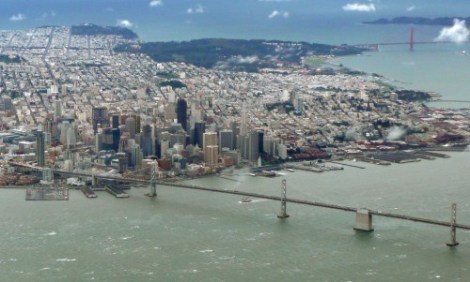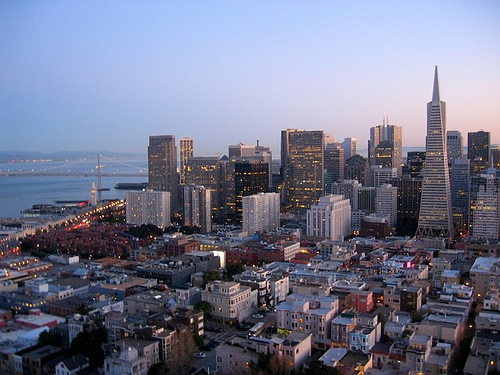Over the past two decades, an influx of tech money has sent rents in San Francisco skyward. It’s the fastest growing rental market in the country, with the East Bay’s Oakland coming in second. Last year, landlords in San Francisco used the “Ellis Act” to evict three times as many tenants as they had in 2011, in order to circumvent rent control.

Ken Layne at The Awl harkens back to a simpler time when you could rent a studio in SF for less than $2,400, and compares that to now:
In 2013, the bigger tech companies are still in Silicon Valley, but the people working there—from Mark Zuckerberg to the newest $100K hires straight out of college—want to be in San Francisco. Zuckerberg is a part-timer, with a fancy apartment in the Mission. The rest are part-timers in Silicon Valley, commuting to and from work on immense luxury buses run by Google, Apple, EA, Yahoo and the rest. This has caused problems, notably for San Francisco residents unlucky enough to survive on less than a hundred-grand starting salary. Talk of raising the city’s skyline is met with anger. People argue endlessly over the appropriate comparisons to New York. Is Oakland the Brooklyn to SF? What about Berkeley, or Marin, or the Outer Sunset? And what does that make Bayview or Burlingame?
All of this assumes that urban San Francisco equals Manhattan. It does not. San Francisco, with its leafy parks and charming row houses and distinct villages and locavore restaurants and commuters fleeing every morning to work, is the Brooklyn to an as-yet-unbuilt Manhattan.
To some extent, this is true. Many parts of San Francisco have become bedroom communities for tech workers who take company-sponsored shuttles or hellish Caltrain routes to work many miles south, to a place where rents are cheaper, but the living is decidedly suburban. The youngs making six figures at start-ups seem to prefer the hell of Caltrain to the hell of Silicon Valley suburbia.
Nobody wants to move to the Bay Area for work and then discover they actually have to live in a completely different climate an hour’s drive (without traffic) from the actual bay. The magical part of the Bay Area is really confined to the Bay Area, with its relatively green hills and foggy mornings and cool ocean air.
So Layne proposes building dense, walkable, appealing neighborhoods in the bleak, sprawling stretch between San Francisco and Silicon Valley some 40 miles to the south. “[I]n the post-automobile era, where else would you look to expand your metropolitan area other than the underused sections in the middle of your metropolitan area?”
[T]he areas around and in between the tech giants of Silicon Valley are mostly ready to be razed and rebuilt. There are miles and miles of half-empty retail space, hideous 1970s’ two-story apartment complexes, most of it lacking the basic human infrastructure of public transportation, playgrounds, bicycle and running and walking paths, outdoor cafes and blocks loaded with bars and late-night restaurants. This is where the new metropolis must be built, in this unloved but sunny valley…
With local light rail at street level and express trains overhead or underground, the whole route could be lined with native-landscaped sidewalks dotted with pocket parks and filled on both sides with ground-floor retail, farmers markets and nightlife districts around every station. Caltrain already runs just east of Route 82, and BART already reaches south to Millbrae now.
Alexis Madrigal at The Atlantic calls this “a wisp of a suggestion, an opening statement, perhaps,” but a “fascinating” one.
But as Layne himself notes, people don’t move to the Bay Area because they want to live an hour’s drive south of San Francisco. Even if we brought a Robert Moses-style urban reckoning upon Silicon Valley (an idea that does have its appeal!), why assume the techies would move there?
This is an aggressively naive idea for a region with a dire housing shortage and a serious cultural bias against density. Instead of a Silicon Valley raze-and-rebuild, how about infilling in San Francisco and East Bay cities where young tech workers already want to be anyway? How about rezoning and remaking Oakland and Berkeley’s desolate, unused industrial brownfields along the waterfront? If it can’t be done in the bigger cities, how likely is it to get done in the many suburbs of Silicon Valley? Not likely at all. Much of the Bay Area doesn’t even want more public transportation, let alone more housing density.
Don’t get me wrong, I love the idea of taking a wrecking ball to empty strip malls. But as a Bay Area resident wishing on a star for the region to grow smarter and denser, I see many more worthy routes to take besides bulldozing the ‘burbs, however delicious the thought.



